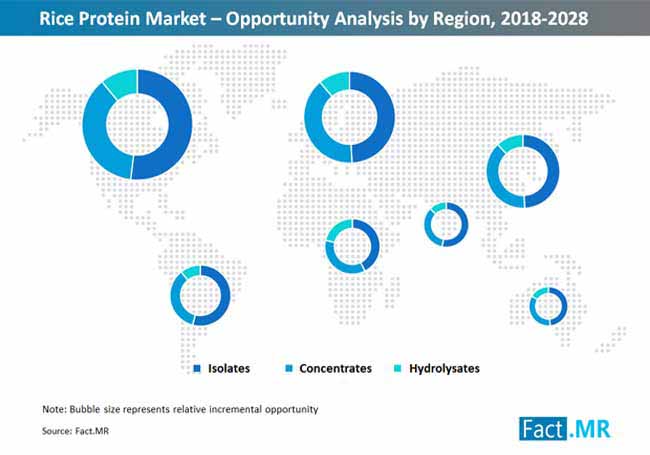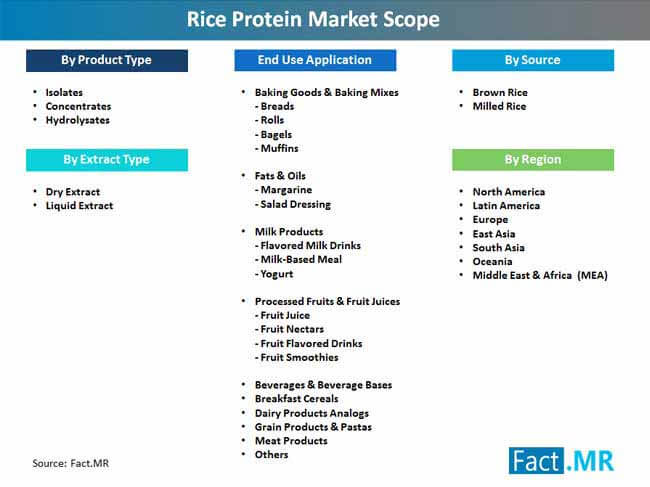
The research report on Organic Rice Protein market offers validated forecast values for critical parameters such as growth rate, revenue, production, consumption, and production with respect to the geographical landscape and competitive backdrop. It enumerates the key growth drivers, restraints, and opportunities shaping the industry dynamics in the upcoming years. In addition, an unbridged study of the COVID-19 pandemic is included for effective decision making amid these uncertain times.
Key highlights from COVID-19 impact analysis:
- Economic consequences of COVID-19 outbreaks.
- Disruptions in supply chain.
- Fluctuations in demand share.
- Immediate and long-term impact of COVID-19 on the growth matrix.
A brief outline of the regional landscape:
- According to the study, the regional scope of the industry spans across North America, Europe, Asia-Pacific, South America, Middle East & Africa, South East Asia.
- Growth rate of each geography during the forecast period is presented in the report.
- Pivotal information regarding revenue generated and sales amassed by each region is discussed at length.
Request Sample Copy of this Report @ https://www.express-journal.com/request-sample/224500
Other highlights from the Organic Rice Protein market report:
- The competitive spectrum of Organic Rice Protein market consists of major companies such as Shafi Gluco-Chem,The Green Labs,Axiom Foods,Top Health Ingredients,Ribus,AIDP,Ricebran Technologies,Bioway (Xi'an) Organic Ingredients,Golden Grain Group andShaanxi Fuheng (FH) Biotechnology.
- Important insights regarding the manufactured products along with business profile, market gains and production patterns of each contender is furnished in the study.
- Industry share held by each contender along with their gross margins and price patterns are also given.
- The product landscape of Organic Rice Protein market is segmented into Rice Protein Concentrates,Rice Protein Isolates andOthers.
- Vitals regarding revenue and volume estimates of all the product types is documented in the report.
- Other aspects such as market share, growth rate and production patterns of every product segment during the forecast years are mentioned.
- The application segment, according to the Organic Rice Protein market report, is fragmented into Sports & Energy Nutrition,Beverages,Bakery & Confectionery,Meat Analogs & Extenders,Dairy Alternatives andOthers.
- The document validates the industry share of every application along with their estimated growth rate during the forecast period.
- Comprehensive analysis of the competition trends, along with a analytical review of the industry supply chain are highlighted.
- SWOT analysis and Porter’s five forces analysis are hosted in the study to discern the feasibility of new project.
Key Highlights from Organic Rice Protein Market Study:
Income and Sales Estimation –
Historical Revenue and deals volume is displayed and supports information is triangulated with best down and base up ways to deal with figure finish market measure and to estimate conjecture numbers for key areas shrouded in the Organic Rice Protein report alongside arranged and very much perceived Types and end-utilize industry. Moreover, macroeconomic factors and administrative procedures are discovered explanations in Organic Rice Protein industry advancement and perceptive examination.
Assembling Analysis –
The Organic Rice Protein report is presently broken down concerning different types and applications. The Organic Rice Protein market gives a section featuring the assembling procedure examination approved utilizing essential data gathered through Industry specialists and Key authorities of profiled organizations.
Demand and Supply and Effectiveness –
Organic Rice Protein report moreover gives support, Production, Consumption, and (Export and Import).
The key questions answered in this report:
- What will be the market size and growth rate in the forecast year?
- What are the key factors driving the Global Organic Rice Protein Market?
- What are the risks and challenges in front of the market?
- Who are the key vendors in the Global Organic Rice Protein Market?
- What are the trending factors influencing the market shares?
- What are the key outcomes of Porter’s five forces model?
- Which are the global opportunities for expanding the Global Organic Rice Protein Market?
Major Points Covered in Table of Contents:
- Organic Rice Protein Market Overview
- Market Competition by Manufacturers
- Production Market Share by Regions
- Consumption by Regions
- Global Organic Rice Protein Production, Revenue, Price Trend by Type
- Global Organic Rice Protein Market Analysis by Applications
- Company Profiles and Key Figures in Organic Rice Protein Business
- Organic Rice Protein Manufacturing Cost Analysis
- Marketing Channel, Distributors, and Customers
- Market Dynamics
- Global Organic Rice Protein Market Forecast
- Research Findings and Conclusion
- Methodology and Data Source
In a word, the Organic Rice Protein Market report provides major statistics on the state of the Organic Rice Protein industry with a valuable source of guidance and direction for companies and individuals interested in the market. In the end, Organic Rice Protein Market report delivers a conclusion which includes Research Findings, Market Size Evaluation, Global Market Share, Consumer Needs along with Customer Preference Change, Data Source. These factors will raise the growth of the business overall.
Request Customization on This Report @ https://www.express-journal.com/request-for-customization/224500

 New Study Reports “Rice Protein Market 2020 Global Market Opportunities, Challenges, Strategies and Forecasts 2026†has been Added on Fact.MR.OverviewStarting from the fundamental details, the report provides a complete overview of the industry along with a proper market profile. The details provided here about the crucial technologies used for manufacturing and product management purpose makes it easier to have a thorough insight into the Global Rice Protein Market. Based on the information obtained, the market has been segmented into various categories. It predicts the growth rate of the Global Rice Protein Market in between the forecasted period, having a base year as 2020.
New Study Reports “Rice Protein Market 2020 Global Market Opportunities, Challenges, Strategies and Forecasts 2026†has been Added on Fact.MR.OverviewStarting from the fundamental details, the report provides a complete overview of the industry along with a proper market profile. The details provided here about the crucial technologies used for manufacturing and product management purpose makes it easier to have a thorough insight into the Global Rice Protein Market. Based on the information obtained, the market has been segmented into various categories. It predicts the growth rate of the Global Rice Protein Market in between the forecasted period, having a base year as 2020.


